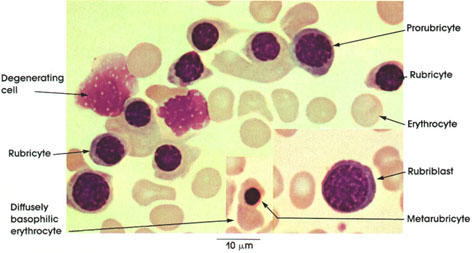

Ronald A. Bergman, Ph.D., Adel K. Afifi, M.D., Paul M. Heidger,
Jr., Ph.D.
Peer Review Status: Externally Peer Reviewed

Human, air-dried marrow smear, Wright's stain, 1416 x.
Rubriblast (proerythroblast, hernocytoblast, myeloblast): Stem cell of the erythroid series with a large rounded nucleus, basophilic cytoplasm.
Prorubricyte (basophilic erythroblast): This develops from the rubriblast. It is smaller than the stem cell, and the nucleus has coarser chromatin. RNA-rich cytoplasm is densely basophilic. Basophilia obscures hemoglobin content. It undergoes mitotic division, giving rise to rubricytes.
Rubricyte (polychromatophilic erythroblast): This is a product of mitotic division of prorubricytes and is smaller than the mother cell. Nuclear chromatin more compact. Cytoplasmic basophilia are less marked and hemoglobin content is greater than in the mother cell. Rubricytes have an affinity for both acid and basic dyes (because of their content of hemoglobin and RNA respectively), which determines their polychromatophilic staining characteristics.
Metarubricyte (normoblast): It arises by mitotic division of the rubricyte. The nucleus is small and pyknotic. Cytoplasm is distinctly aciclophilic owing to increased hemoglobin content.
Erythrocyte: Non-nucleated (nuclei of metarubricytes have been extruded) with circular outline. In side view, they appear dumbbell-shaped because of the biconcave nature of their surfaces. The number varies in man from 5 to 5.5 million per cubic mm. They carry oxygen from lungs to.tissue and carbon dioxide from tissue to lungs, and are filled with hemoglobin. immature stages in development (reticulocytes) have a diffusely basophilic cytoplasm because of the residual content of RNA.
Degenerating cell: Often found in bone marrow. They are remnants of damaged corpuscles, megakaryocytes, or myeloblasts. These are primarily artifacts of a marrow smear preparation.
Next Page | Previous Page | Section Top | Title Page
Please send us comments by filling out our Comment Form.
All contents copyright © 1995-2025 the Author(s) and Michael P. D'Alessandro, M.D. All rights reserved.
"Anatomy Atlases", the Anatomy Atlases logo, and "A digital library of anatomy information" are all Trademarks of Michael P. D'Alessandro, M.D.
Anatomy Atlases is funded in whole by Michael P. D'Alessandro, M.D. Advertising is not accepted.
Your personal information remains confidential and is not sold, leased, or given to any third party be they reliable or not.
The information contained in Anatomy Atlases is not a substitute for the medical care and advice of your physician. There may be variations in treatment that your physician may recommend based on individual facts and circumstances.
URL: http://www.anatomyatlases.org/